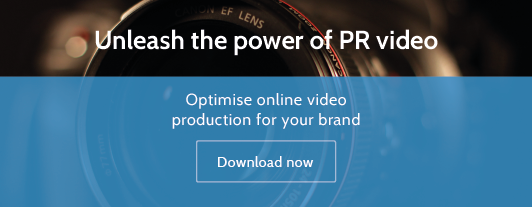B-roll. You may have heard it mentioned, but if pressed can you really explain what it is? And more importantly – why you should care? Well, you should care because B-roll might just be the thing that clinches coverage for your story on TV and online, and makes you popular with broadcasters. Now you’re interested right? Read on to find out what B-roll is and how you can use it to your advantage.
What is B-roll?
When we talk about B-roll, what we mean is very loosely edited footage that is offered rights and royalty free to journalists/broadcasters, who can then cut it up in any way that they see fit. Usually a roll would include some talking head interview clips, and some additional footage relating to what the talking head is speaking about. So if the interviewee is discussing a product launch the B-roll would feature footage of that product. B-roll is always simply cut, with black slates introducing each segment. Check out an example of B-roll below.
How to shoot B-roll
Editors will use B-roll that is supplied to them to make packages in their own in-house style. So when creating B-roll it’s essential that you give them enough to work with. Make sure that the footage is really loosely edited with plenty of potential edit points. B-roll should look messy – it will never go to air like that so don’t worry about each shot looking perfect. Similarly, interview clips should be complete. You can’t take out a word here-or-there as this will impact how journalists can use the material, and don’t worry about um’s and errr’s either – these will also be removed during the editing process. Make shots long and film in the classic news style with slow pans and zooms. You might like the look of crash zooms or whip pans but most broadcast news outlets wouldn’t use this kind of footage so stick with the standard news style. If you’re not sure what this means ask you camera operator for advice.
How to distribute B-roll
Long gone are the days of bikers couriering tapes to journalists. The best way to distribute B-roll is either using a file sharing site such as Dropbox or Wetransfer or to use a news distribution site where the files can also usually stay on archive for future opportunities. Always keep in mind that if you are delivering files for broadcasters then they will need to be broadcast quality – which means they will be big files. So make sure you’ve got enough time to upload them, and be sure to upload them in an area with strong internet.
The advantages of B-roll
So you understand what it is and how to make and distribute B-roll. But why bother? The truth is that journalists don’t like to admit it, but they welcome B-roll and are far more likely to run a story if they’ve got some footage to go with the press release. Cuts to newsroom budgets mean that there aren’t always enough resources to collect all the footage needed and if you can offer good quality B-roll, either to accompany a live guest (e.g. footage of a chef cooking while they sit on the sofa and have a live chat with Bill and Louise) or for use in a package, then that takes some of the pressure off the journalist – which not only means they you’ll secure coverage this time, but will also lead them to think favourably of you next time you have a story to pitch – win win!
For more on B-roll you can check out our related blog or why not download our video e-book to find out more about different types of video for PR.




